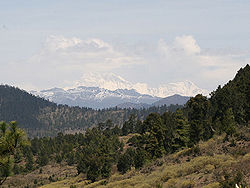Kashmir/Punjab - Between Indus and Sutlej Rivers


| No | Peak | Country | Elevation (m) | Prominence (m) | Col (m) |
|---|---|---|---|---|---|
| 1 | Nanga Parbat | 8,125 | 4,608 | 3517 | |
| 2 | Nun | 7,135 | 2,404 | 4731 | |
| 3 | Shikar Beh | 6,200 | 2,223 | 3977 | |
| 4 | Parbati Parbat | 6,633 | 2,093 | 4540 | |
| 5 | Reo Purgyil | 6,816 | 1,978 | 4838 | |
| 6 | Sunset Peak | 4,745 | 1,942 | 2803 | |
| 7 | Miranjani | 2,981 | 1,911 | 1070 | |
| 8 | Gya | 6,794 | 1,910 | 4884 | |
| 9 | Dofana | 5,940 | 1,875 | 4065 | |
| 10 | Point 5608 | 5,608 | 1,850 | 3758 | |
| 11 | Manirang | 6,593 | 1,727 | 4866 | |
| 12 | Point 5800 | 5,800 | 1,682 | 4118 | |
| 13 | Point 6086 | 6,086 | 1,618 | 4468 | |
| 14 | Bharanzar | 6,574 | 1,606 | 4968 | |
| 15 | Mulkila | 6,517 | 1,586 | 4931 | |
| 16 | Kolahoi | 5,425 | 1,585 | 3840 | |
| 17 | Point 5971 | 5,971 | 1,566 | 4405 | |
| 18 | Junkor | 5,373 | 1,563 | 3810 | |
| 19 | Doda | 6,573 | 1,504 | 5069 | |










